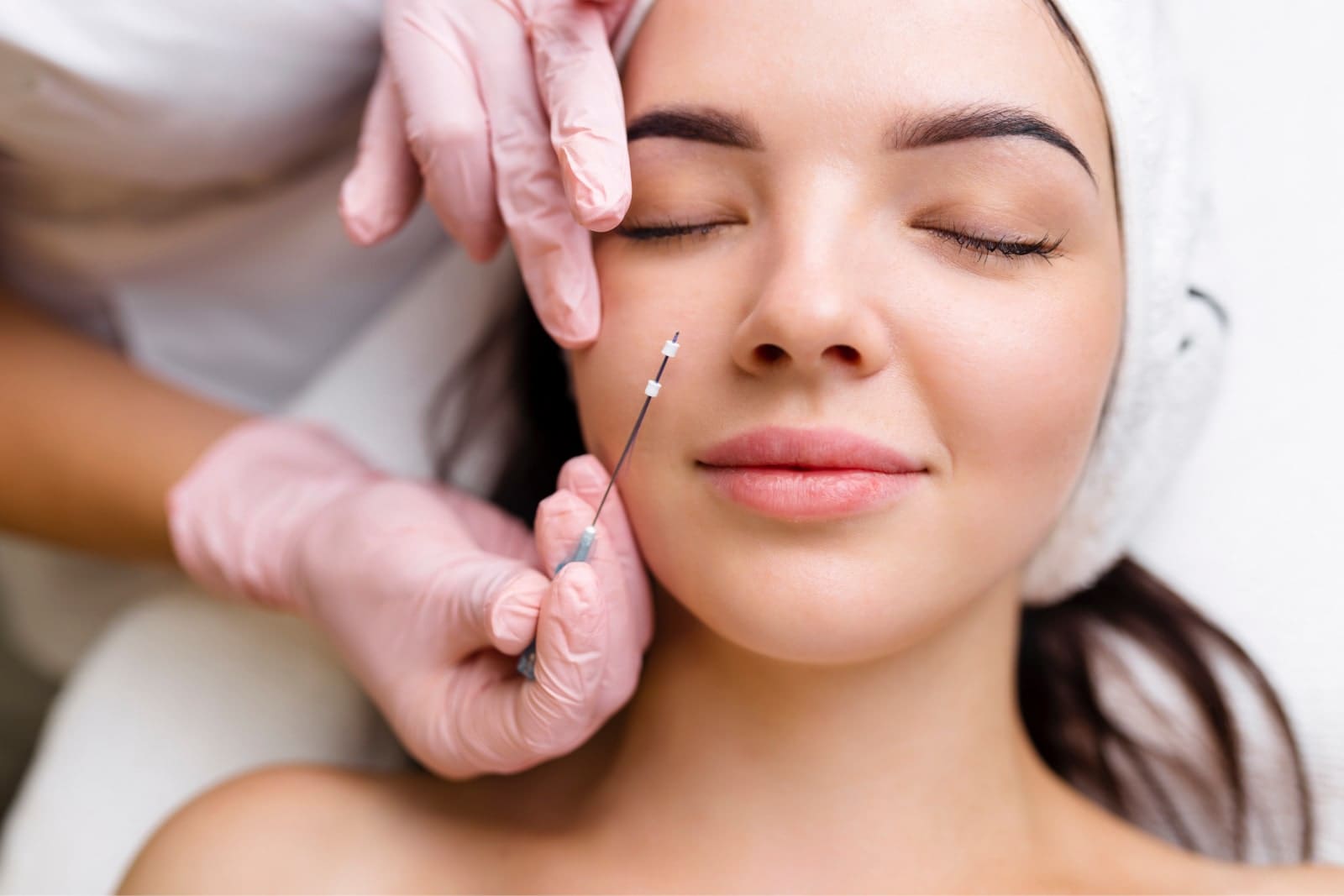Chemical peels, which have a longstanding history dating back to the days of Cleopatra, are one of the most popular ways to refresh, rejuvenate, and retexturize the skin non-invasively. Tackling everything from acne to acne scars and even hyperpigmentation, fine lines, wrinkles, and overall dullness, the benefits of chemical peels are worth it as long as they are performed in the right hands. By exfoliating the skin with specific skin-safe acids, the modern-day chemical peel, which comes in various concentrations to reach the different depths of the skin, safely forces dead and damaged skin cells to lift away, revealing fresh, new, healthy skin underneath for more evenly toned and textured skin.
Peeling Away the Myths: What Chemical Peels Can and Can’t Do
There are many benefits of chemical peels, but there are also many things that even the best chemical peels cannot do. And there are a lot of misconceptions about peels and chemical peel benefits, too. Some of the biggest chemical peel misconceptions include:
- Heavy post-peel peeling: Not all chemical peels induce physical peeling. One benefit of a chemical peel tailored to your skin type is that some peels can exfoliate the skin without eliciting a peeling response. Just because the chemical peel doesn’t cause peeling doesn’t mean it won’t benefit your skin.
- Chemical peels aren’t beneficial for those with sensitive skin: Your skin type will dictate the best chemical peel for you, but sensitive skin isn’t omitted from the treatment. If you have sensitive skin, several peels can be used as long as they contain acids that work to reduce inflammation and redness and have calming and soothing agents.
- One chemical peel is all you need: While you’ll see some skin improvement from a single chemical peel, to reap the benefits, it’s best to commit to a series to see optimal results. Six to eight peels every four to six weeks are usually recommended, with a maintenance plan thereafter.
- There’s always intense redness and irritation post-peel: While it’s normal for the skin to be mildly red and irritated after a chemical peel, it doesn’t happen with every type of peel or after every treatment session. Even if redness and irritation ensue, it doesn’t mean that your skin is damaged, and any redness and irritation should subside within a day or two.
- Chemical peels only benefit acne-prone skin: No matter your skin issue, there’s a chemical peel for you. Peels can work wonders in clearing out clogged and congested pores to help clear up acne, but they can also be used for general skin maintenance to keep it looking clean, healthy, and smooth.
- Chemical peels should never be done on dry skin. One of the many benefits of chemical peels is exfoliating and removing dead skin cells, which can cause the skin to feel extra dry and dull. By eliminating dead skin cells, the skin’s moisture barrier also improves, so your moisturizers and other hydrating products work that much better.
The best chemical peel for your skin type will address your most pressing skin concern. With routine chemical eels, you can expect to see skin texture and tone improvement, fewer breakouts, less discoloration, smoother-looking skin with fewer lines and wrinkles, and an overall improved glow to the skin. Our patients find chemical peel benefits to tap into common skin concerns that often include:
- Getting rid of brown spots, freckles, and age spots
- Reducing active acne breakouts and improving acne scars
- Stimulating collagen creation for more youthful-looking skin
- A decrease in wrinkles and fine lines
- Smoother-looking skin with less roughness
Deep Dive into Benefits: The Multifaceted Impact of Chemical Peels
Different chemical peels have different skin benefits, which are all dictated by the type of peel used and the concentration of the exfoliation acids. The most common types of chemical peels include:
Light, superficial chemical peels
The best chemical peel for lightening up and smoothing out more mild pigmentation and sun damage is a light chemical peel. Counting hydroxy acids (both AHA and BHAs) as the primary peeling agent, these quick and easy peels can improve the skin’s overall quality, tone, and texture. They are also a go-to for treating small pimples, blackheads, and whiteheads. A light chemical peel benefits younger skin that is still healthy, and because the acids used exfoliate more superficially, there’s usually not a lot of peeling and flaking due to the mildness of the treatment.
Medium-strength chemical peels
Medium-strength peels are a step up from superficial ones. These peels are well suited for mature skin with more prominent pigmentation, sun damage, and common signs of aging. Since these peels are delivered deeper into the skin for more profound effects, there is usually more flaking, tightness, dryness, and even redness after performing one. However, medium-strength peels also provide the benefit of added collagen production for plumper, firmer, younger-looking skin.
Deep chemical peel
The most extreme peel, a deep chemical peel, is reserved for extreme skin aging and is done only once. Deep peels count on phenol as the peeling agent, which must be done under anesthesia and is usually performed alongside a facelift. These deep peels come with a much higher risk of complications and about two weeks of extreme downtime and recovery.
Typically, chemical peels are used on the face, but they can also improve common skin problems and other concerns that extend beyond the neck. Chemical peels can also treat the skin on the neck, décolletage, and hands.
Customization is Key: Tailoring the Peel to Your Unique Skin
Chemical peel benefits vary; adapting the peel to your skin allows for customized results. From more gentle glycolic peels to deeper TCA ones, we pride ourselves on skincare assessments and creating an individual skincare plan to ensure each client receives the proper chemical peel treatment. With a personalized approach, we can help you achieve optimal results with minimal downtime. Because skin care is not one-size-fits-all, and neither are your chemical peels, taking a personalized approach and considering skin type is essential for the skin to reap the benefits.
Walking the Journey with You: Our Medspa’s Dedication to Excellence
At Ecobel Med Spa, we are committed to helping you find the best chemical peel for your skin type that addresses your skin’s needs. We pride ourselves on using only top-grade professional chemical peels with safe ingredients and acids to provide the best benefits. Our highly trained skin experts ensure that every chemical peel we perform is customized, effective, and an overall enjoyable experience. We continuously uphold a deep commitment to skincare excellence, helping you to achieve all your skincare goals.
Common FAQs
Can I see the results after one chemical peel?
While you will see results with just one chemical peel, the best benefits of chemical peels come from a series of treatments. Just one peel will leave the skin with an improved skin tone and texture, fewer breakouts, and decreased pigmentation. Still, if you have skin concerns such as sun damage, acne scarring, or deeper wrinkles, multiple sessions may be needed to achieve your desired results.
How long does it take for the skin to heal after a chemical peel?
The type of peel used determines how long the skin will peel and whether it will peel at all. Depending on the strength of the peel, the treated areas may fade and peel for one to seven days.
What is the most effective chemical peel?
The most effective peel is the one that works best for your skin type. At Ecobel Med Spa, we offer Dennis Gross Skincare and Sesderma chemical peels and find that our clients are pleased with the results.




